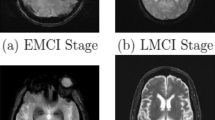Abstract
We present a new approach to model 2D surfaces and 3D volumetric data, as well as an approach for non-rigid registration; both are developed in the geometric algebra framework. The approach for modeling is based on marching cubes idea using however spheres and their representation in the conformal geometric algebra; it will be called marching spheres. Note that before we can proceed with the modeling, it is needed to segment the object we are interested in; therefore, we include an approach for image segmentation, which is based on texture and border information, developed in a region-growing strategy. We compare the results obtained with our modeling approach against the results obtained with other approach using Delaunay tetrahedrization, and our proposed approach reduces considerably the number of spheres. Afterward, a method for non-rigid registration of models based on spheres is presented. Registration is done in an annealing scheme, as in Thin-Plate Spline Robust Point Matching (TPS-RPM) algorithm. As a final application of geometric algebra, we track in real time objects involved in surgical procedures.
Similar content being viewed by others
References
Ho, S., Bullitt, E., Gerig, G.: Level-set evolution with region competition: automatic 3-D segmentation of brain tumors. In: Proceedings of 16th International Conference on Pattern Recognition, vol. 1, pp. 532–535 (2002)
Prastawa, M., Bullit, E., Ho, S., Gerig, G.: A brain tumor segmentation framework based on outlier detection. Med. Image Anal. J. 8(3), 275–283 (2004)
Moon, N., Bullit, E., van Leemput, K., Gerig, G.: Model based brain and tumor segmentation. In: Proceedings of the 16th International Conference on Pattern Recognition, August 11–15, 2002, Quebec City, QC, Canada, pp. 528–531
Moon, N., Bullit, E., van Leemput, K., Gerig, G.: Automatic brain and tumor segmentation. In: Proceedings of the Fift International Conference on Medical Image Computing and Computer Assisted Intervention 2002, September 25–28, 2002, Tokyo, Japan. LNCS vol. 2489, pp. 372–379. Springer, Berlin (2002)
Prastawa, M., Bullit, E., Gerig, G.: Robust estimation for brain tumor segmentation. Med. Image Comput. Comput. Assist. Interv. (2), 530–537 (2003)
Andrade, M.C.: An interactive algorithm for image smoothing and segmentation. Electron. Lett. Comput. Vis. Image Anal. 4(1), 32–48 (2004)
Lin, P., Zheng, C., Yang, Y., Gu, J.: Medical image segmentation by level set method incorporating region and boundary statistical information. In: 9th Iberoamerican Congress on Pattern Recognition, National Institute of Astrophysics, Optics and Electronics (INAOE), Puebla, Mexico, pp. 654–660 (October 2004)
Gering, D.T.: Diagonalized nearest neighbor pattern matching for brain tumor segmentation. Med. Image Comput. Comput. Assist. Interv. 2, 670–677 (2003)
Hong, H., Lee, H., Hyun, S., Gil, Y.: Cerebral vessel enhancement using rigid registration in three-dimensional CT angiography. In: Sanfeliu, A., et al. (eds.) LNCS vol. 3287, pp. 541–549. Springer, Berlin (2004)
Ranjan, V., Fournier, A.: Union of spheres (UoS) model for volumetric data. In: Proceedings of the Eleventh Annual Symposium on Computational Geometry, Vancouver, Canada, 1995, C2–C3, pp. 402–403
Chui, H., Rangarajan, A.: A new point matching algorithm for non-rigid registration. In: IEEE Conf. on Computer Vision and Pattern Recognition (CVPR), vol. 2, pp. 44–51 (2000)
Muñoz, X.: Image segmentation integrating color, texture and boundary information. Ph.D. Thesis in Computer Engineering, Girona (December 2002)
Fu, K.S., Mui, J.K.: A survey on image segmentation. Pattern Recogn. 12, 395–403 (1980)
Chantler, M.J.: The effect of variation in illuminant direction on texture classification. Ph.D. thesis, Dept. Computing and Electrical Engineering, Heriot-Watt University (August 1994), pp. 67–89
Tamura, H., Mori, S., Yamawaki, T.: Textural features corresponding to visual perception. IEEE Trans. Syst. Man Cybern. 8(6), 460–473 (1980)
Lorensen, W., Cline, H.: Marching cubes: a high resolution 3D surface construction algorithm. Comput. Graph. 21(4), 163–169 (1987)
Zhang, Z.: Iterative point matching for registration of free-form curves. Technical Report 1658, INRIA (1992)
Rosenhahn, B., Sommer, G.: Pose estimation in conformal geometric algebra. Technical Report 0206, Christian-Albrechts-University of Kiel (November 2002), pp. 13–36
Lasenby, J., Lasenby, A.N., Doran, C., Fitzgerald, W.J.: New geometric methods for computer vision—an application to structure and motion estimation. Int. J. Comput. Vis. 26(3), 191–213 (1998)
Bayro-Corrochano, E., Rivera-Rovelo, J.: Non-rigid registration and geometric approach for tracking in neurosurgery. In: International Conference on Pattern Recognition, Cambridge, UK, August 2004, pp. 717–720
Author information
Authors and Affiliations
Corresponding author
Rights and permissions
About this article
Cite this article
Bayro-Corrochano, E., Rivera-Rovelo, J. The Use of Geometric Algebra for 3D Modeling and Registration of Medical Data. J Math Imaging Vis 34, 48–60 (2009). https://doi.org/10.1007/s10851-008-0123-0
Received:
Accepted:
Published:
Issue Date:
DOI: https://doi.org/10.1007/s10851-008-0123-0




